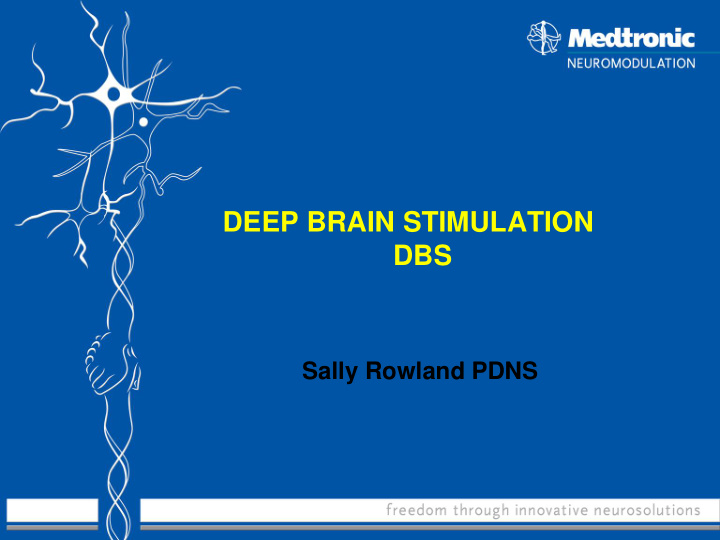



DEEP BRAIN STIMULATION DBS Sally Rowland PDNS
Patient Selection for DBS • Parkinson’s STN Subthalamic nucleus • Tremor Vim Thalamus • Dystonia Gpi Pallidum
Parkinson’s • Parkinson’s (PD) is a chronic, progressive neurodegenerative disorder • The condition is caused by the reduction of Dopamine producing cells in the substantia nigra ( part of the basal ganglia) within the brain • The loss of Dopamine (a neurotransmitter) results in uncoordinated movement. • Second most common movement disorder (1 in 500 people in UK – 127,000)
PD anatomy - video clip
Clinical Features of Parkinson’s • Bradykinesia/Akinesia (‘Mask - like appearance’ when it affects the face) • Tremor • Rigidity • Postural Instability • (80% of dopamine-producing cells are lost before the motor symptoms occur)
Clinical Features Essential Tremor • Single or bilateral hand tremor • 40% of patients have a head tremor • 20% have a voice tremor
Clinical Features of Dystonia • Dystonia is a syndrome of sustained muscle contractions • Frequent twisting repetitive abnormal postures • Generalized Dystonia refers to a combination of body parts that are affected
How is Parkinson’s treated? • Medication • Supplemental therapies - Exercise - Physical Therapy - Speech therapy - Environmental modification - Gait aids • Surgical treatment - DBS (Deep Brain Stimulation)
PD medication video clip
When medication is not enough? • As PD progresses medications may fail to provide adequate symptom control • Medications used at the levels required for adequate symptom control may produce adverse side effects - Motor complications, ie dyskinesia - Cognitive and psychiatric problems - Nausea, hypotension and other systemic effects
When should DBS be considered? • When, despite adequate medication the patient experiences troublesome motor symptoms, which might include: - Wearing off – off periods that contain troubling bradykinesia, rigidity, tremor and /or gait problems - Troubling dyskinesia - Motor fluctuations
PD and DBS – video clip
Walking PD patient – on and off
PD patient - DBS switch on - off
DBS is not a cure BUT: • DBS improves patients quality of life • It is a reversible procedure • Non destructive vs ablative procedure • Can be non invasively fine tuned to individuals needs • Cost effective – reduction of medication in STN patients • Long term safety profile (0.4% mortality comparable to total hip replacement)
DBS kit Activa PC, extensions, leads Patient programmer
THANK YOU Any questions?
Recommend
More recommend